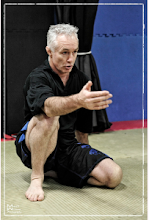
Weaving order from the chaos of the fight experience is something that brings me joy and pleasure. Having my students participate in this ‘ordering’ process is something that I have found to be hugely beneficial to their learning experience.
Providing a means for the student to take a greater level of ownership of the learning experience not only makes my task as a teacher more enjoyable – it also produces a marked improvement in the desired outcomes of the class. There are a number of different teaching strategies that I have come up with to more fully engage the students in the learning experience.
One of my most powerful tools is my concept of ‘running the checklist’. The checklist is a road-map for the given technique or drill; providing the student with a concise and well-ordered pathway from the beginning to the end of a technique or drill. The checklist refers to the series of steps the student must take to negotiate this pathway. The words we use to describe each of these steps should ideally be short and descriptive (mono-syllabic if possible). I may well begin by describing the technique with as much use of language as is needed – but I will quickly reduce back to the use of monosyllabic descriptions of each stage of the technique – in other words, I start with my thorough description to build agreement and understanding but shrink back to my checklist as quickly as is feasible.
In having my students ‘run’ the checklist as part of their learning process, they get to tap into the sense of joy and flow that I myself experience as the designer of the class or teaching model. The student also experience a sense of early achievement as they successfully run the checklist and take ownership of the material.
Running the checklist also keeps the student involved in the process of the technique – it keeps them ‘in the moment’ and helps prevent them from making the very common mistake of over-focussing on the ‘goal’ or ‘end phase’ of the task. Staying in the ‘now’ – being ‘present’ at every step of the process – provides not only a better result, but a better level of ownership for the aspiring coach/instructor.
If the checklist is well-constructed, the instructor/trainer can keep the class moving through the process at the ‘speed of life’. Overuse of descriptive verbage during instruction can result in a hardwiring of the ‘pauses’ between each stage of the technique or drill. A well-constructed checklist will keep things moving at good speed and the students will more easily develop flow and continuity during the state of action.
Finally, the construction of a good checklist will make it more likely that the technique or drill will be reproduced more accurately at a later date when it is passed on or re-delivered by a third party. To develop the skill for constructing a viable checklist takes practice and work but it is very definitely a skill worth mastering. It will take your understanding, sense of ownership and ability to pass on what you have learned to others – to a whole new level.
Best wishes
JBW
Subscribe by Email
Follow Updates Articles from This Blog via Email





















No Comments